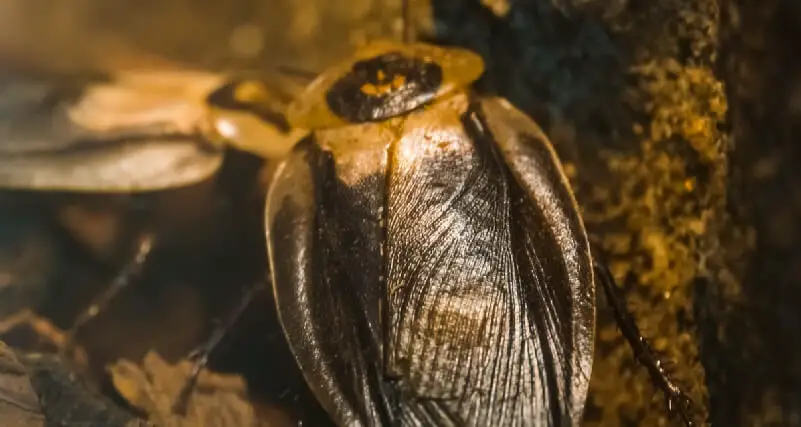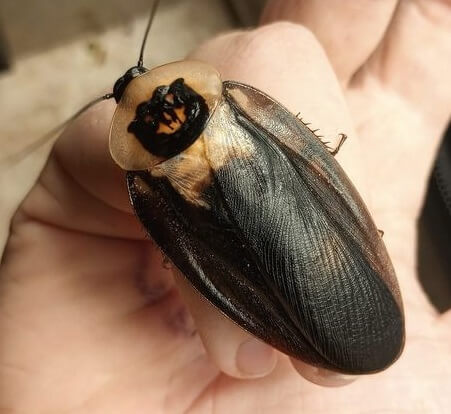Death’s Head Cockroach Facts

Regarding cockroaches, the term “interesting” rarely comes to mind. However, the Death’s Head Cockroach is an exception to the rule, fascinating scientists and insect enthusiasts alike.
With its unique markings and behaviors, this insect species has caught the attention of many, even becoming a trendy choice for pet owners looking for an unusual companion.
Quick Facts
| Feature | Information |
|---|---|
| Species Name | Blaberus craniifer |
| Alternative Name | Discoid cockroach (False death head) |
| Population Size | Millions |
| Biggest Threat | Birds, reptiles |
| Distinctive Feature | Skull-shaped mark on its carapace |
| Gestation Period | 3 – 4 weeks |
| Litter Size | 34 eggs |
| Habitat | Woods, forests, jungles |
| Predators | Birds, reptiles, spiders |
| Diet | Omnivore |
| Color | Brown, Black |
| Skin Type | Hard Outer Shell |
| Lifespan | 1 year |
| Weight | Less than 1 ounce |
| Length | More than 2 inches |
| Age of Sexual Maturity | 4 – 5 months |
Two Types, One Name
Before diving more deeply, it’s crucial to clarify that there are two species commonly called “Death’s Head Cockroaches”: the Blaberus craniifer and the discoid cockroach.
The Blaberus craniifer is the true Death’s Head Cockroach, easily distinguished by its skull-like marking on the thorax. The wings of this species are also jet black, adding to its iconic appearance.
On the other hand, the discoid cockroach is sometimes termed the “false” death’s head due to its less elaborate markings and differently colored wings.

Dazzling Features
Its most striking feature is the skull-shaped mark on the actual Death’s Head Cockroach’s carapace. This naturally occurring design has fueled its popularity, and many view it as a tattoo of the insect world. They have a hard outer shell, typically in shades of brown or black, which offers protection from predators.
Defense Mechanisms
Death’s Head Cockroaches rely on their intimidating appearance for defense and emit strong odors to ward off threats. This chemical arsenal is particularly effective against potential predators like birds, reptiles, and spiders, deterring them from making a meal out of the cockroach.
As Unlikely Pets
People buy Death’s Head Cockroach nymphs and raise them as pets! Yes, you read that correctly. Despite their intimidating name and appearance, these creatures increasingly find homes in human habitats as pets, much to the delight of insect aficionados.
Lifecycle & Reproduction
The gestation period for a Death’s Head Cockroach is quite short, between 3 to 4 weeks. A single litter can produce about 34 eggs, contributing to their significant population size, estimated to be in the millions. They reach sexual maturity at 4 to 5 months and have a lifespan of approximately one year.
Where Do They Live?
These creatures can be found in various natural habitats, such as woods, forests, and jungles. They are omnivores, which means their diet is quite versatile, including plant material and small insects. While birds and reptiles are their most significant threats, they can also fall prey to spiders.
Final Thoughts
Despite their off-putting name and appearance, Death’s Head Cockroaches are fascinating creatures that look into the insect world’s intricate beauty and complexity.
Whether you find them intriguing enough to keep as pets or appreciate them for their unique features, there’s no denying that these cockroaches are a fascinating study of survival, adaptation, and natural design.
So the next time you think of cockroaches as mere pests, remember the Death’s Head Cockroach. It may change the way you view these often misunderstood creatures.

James E. Butkovich, Pest control maven with a knack for eco-friendly & Chemical solutions. Blogger with a mission to make homes pest-free, one post at a time.